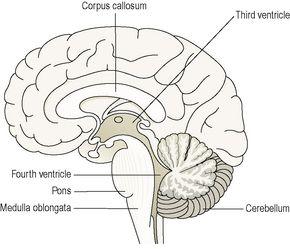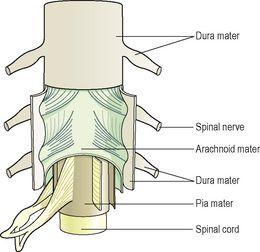Ross & Wilson Anatomy and Physiology in Health and Illness (71 page)
Read Ross & Wilson Anatomy and Physiology in Health and Illness Online
Authors: Anne Waugh,Allison Grant
Tags: #Medical, #Nursing, #General, #Anatomy

The pons is situated in front of the cerebellum, below the midbrain and above the medulla oblongata. It consists mainly of nerve fibres (white matter) that form a bridge between the two hemispheres of the cerebellum, and of fibres passing between the higher levels of the brain and the spinal cord. There are nuclei within the pons that act as relay stations and some of these are associated with the cranial nerves. Others form the
pneumotaxic
and
apnoustic centres
that operate in conjunction with the respiratory centre in the medulla oblongata.
The anatomical structure of the pons differs from that of the cerebrum in that the cell bodies (grey matter) lie deeply and the nerve fibres are on the surface.
Medulla oblongata
The medulla oblongata, or simply the medulla, extends from the pons above and is continuous with the spinal cord below. It is about 2.5 cm long and it lies just within the cranium above the foramen magnum. Its anterior and posterior surfaces are marked by central fissures. The outer aspect is composed of white matter, which passes between the brain and the spinal cord, and grey matter, which lies centrally. Some cells constitute relay stations for sensory nerves passing from the spinal cord to the cerebrum.
The
vital centres
, consisting of groups of cell bodies (nuclei) associated with autonomic reflex activity, lie in its deeper structure. These are the:
•
cardiovascular centre
•
respiratory centre
•
reflex centres of vomiting, coughing, sneezing and swallowing.
The medulla oblongata has several special features.
Decussation (crossing) of the pyramids
In the medulla, motor nerves descending from the motor area in the cerebrum to the spinal cord in the pyramidal (corticospinal) tracts cross from one side to the other. This means that the left hemisphere of the cerebrum controls the right half of the body, and vice versa. These tracts are the main pathway to skeletal (voluntary) muscles.
Sensory decussation
Some of the sensory nerves ascending to the cerebrum from the spinal cord cross from one side to the other in the medulla. Others decussate lower down in the spinal cord.
The cardiovascular centre (CVC)
This area controls the rate and force of cardiac contraction (
p. 88
). It also controls blood pressure (
p. 88
). Within the CVC, other groups of nerve cells forming the
vasomotor centre
(
p. 76
) control the diameter of the blood vessels, especially the small arteries and arterioles. The vasomotor centre is stimulated by the arterial baroreceptors, body temperature and emotions such as sexual excitement and anger. Pain usually causes vasoconstriction although severe pain may cause vasodilation, a fall in blood pressure and fainting.
The respiratory centre
This area controls the rate and depth of respiration. From here, nerve impulses pass to the phrenic and intercostal nerves which stimulate contraction of the diaphragm and intercostal muscles, thus initiating inspiration. It functions in close association with the pnuemotaxic and apneustic centres in the pons (see
p. 252
).
Reflex centres
Irritants present in the stomach or respiratory tract stimulate the medulla oblongata, activating the reflex centres. The vomiting, coughing or sneezing reflexes then attempt to expel the irritant.
Reticular formation
The reticular formation is a collection of neurones in the core of the brain stem, surrounded by neural pathways that conduct ascending and descending nerve impulses between the brain and the spinal cord. It has a vast number of synaptic links with other parts of the brain and is therefore constantly receiving ‘information’ being transmitted in ascending and descending tracts.
Functions
The reticular formation is involved in:
•
coordination of skeletal muscle activity associated with voluntary motor movement and the maintenance of balance
•
coordination of activity controlled by the autonomic nervous system, e.g. cardiovascular, respiratory and gastrointestinal activity (
p. 167
)
•
selective awareness that functions through the
reticular activating system
(RAS), which selectively blocks or passes sensory information to the cerebral cortex, e.g. the slight sound made by a sick child moving in bed may arouse his mother but the noise of regularly passing trains does not disturb her.
Cerebellum
The cerebellum (
Fig. 7.25
) is situated behind the pons and immediately below the posterior portion of the cerebrum occupying the posterior cranial fossa. It is ovoid in shape and has two hemispheres, separated by a narrow median strip called the
vermis
. Grey matter forms the surface of the cerebellum, and the white matter lies deeply.
Figure 7.25
The cerebellum and associated structures.
Functions
The cerebellum is concerned with the coordination of voluntary muscular movement, posture and balance. Cerebellar activity is not under voluntary control. The cerebellum controls and coordinates the movements of various groups of muscles ensuring smooth, even, precise actions. It coordinates activities associated with the
maintenance of posture, balance
and
equilibrium
. The sensory input for these functions is derived from the muscles and joints, the eyes and the ears.
Proprioceptor impulses
from the muscles and joints indicate their position in relation to the body as a whole, and those impulses from the eyes and the semicircular canals in the ears provide information about the position of the head in space. Impulses from the cerebellum influence the contraction of skeletal muscle so that balance and posture are maintained.
The cerebellum may also have a role in learning and language processing.
Damage to the cerebellum results in clumsy uncoordinated muscular movement, staggering gait and inability to carry out smooth, steady, precise movements.
Spinal cord
Learning outcomes
After studying this section you should be able to:
describe the gross structure of the spinal cord
state the functions of the sensory (afferent) and motor (efferent) nerve tracts in the spinal cord
explain the events of a simple reflex arc.
The spinal cord is the elongated, almost cylindrical part of the central nervous system, which is suspended in the vertebral canal surrounded by the meninges and cerebrospinal fluid (
Fig. 7.26
). The meninges are described on
page 145
. The spinal cord is continuous above with the medulla oblongata and extends from the upper border of the atlas to the lower border of the 1st lumbar vertebra (
Fig. 7.27
). It is approximately 45 cm long in adult males, and is about the thickness of the little finger. A specimen of cerebrospinal fluid can be taken using a procedure called
lumbar puncture
(
p. 147
).



